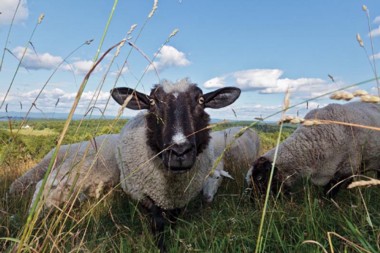When Barbara Parry began offering wool by subscription through her farm in Shelburne, she called it a club. “I modeled it on other wool clubs,” she explains. “What became clear, though, is that club was the wrong word, the wrong idea. That’s because people were interested in this farm. They wanted to know where their wool came from. So we began to use the phrase Wool CSA. I like CSA much better. This makes it clear that you’re supporting what goes on at an actual farm.” Parry began to offer Sheep Shares through Foxfire Fiber and Design at Springdelle Farm.
Upwards of 170 members, both local and far from local—the farthest-flung members are in Australia and Brazil—belong to the CSA, which distributes wool three times a year. Regardless of proximity to or distance from the farm, members consider Springdelle “their” farm. For a members’ event—such as the “Strolling of the Lambs”—some people came from nearby Shelburne or Amherst, others from as far away as New Jersey and Philadelphia. As Alison Kelsey of Philadelphia said, “I’ve been a member for two years, and I’ve been reading about this farm through Barbara’s blog, and I just wanted to see it. I already know the animals by name.”
Parry started her Sheepgal blog so members would feel connected to the life of the farm. “The blog turns out to be key to my business,” she explains. “Through reading, people become invested in what’s happening at the farm, and begin to appreciate what farming is. They are along for the ride, even when things crash and burn. And things do crash and burn on a farm… the rain affects the coats or the crops we grow to feed the sheep. We’re weather-dependent.”
Kelsey concurs about Parry’s helping members connect with the experience of farm life. “I found sites for a few wool CSAs,” she says. “Barbara’s had the most appeal—not just the yarn, also the care she seemed to take about raising the best fiber.” Between her blog and some freelance work—Parry has a series of articles on the Twist Collective site about a fifty-mile fiber diet—a book deal came together; her Adventures in Yarn Farming is forthcoming next year from Shambala Press.
Parry didn’t begin her career as a farmer or a wool dyer or in fiber arts. Formerly a middle school English teacher, Parry taught until her son went to boarding school. Meanwhile she’d gotten interested in hand spinning.
“We cared for our neighbors’ sheep when they went away, sometimes during lambing season,” she says. “We had room for a couple of sheep ourselves. I washed and carded their wool. I was trying to imagine a second act, post-teaching, one that would be creative.” Her husband, too, was at the point where he could embark on a new dream.
They didn’t dream of a 220-acre farm.
“We started looking at farms up in West County,” Parry recalls, “small farms.” The farm they ended up with had been a cow farm, but the owners were moving to New York State with their cows. “We were told the land wasn’t ideal for cows,” Parry says. “The idea of ensuring that the farmland remained intact—all 220 acres of it—and living in a spot where even in 20 years we’ll be the new people appealed.
“It just came about so organically. We started very slowly because we had no notion how many sheep the land could support or how much hay the sheep needed. There was a steep learning curve, a lot of fine-tuning. We had no manual. We’ve been extremely fortunate to have such generous neighbors and friends who gave of their time and knowledge.” Springdelle Farms had 80 adult sheep and 13 lambs this past year.
Parry says, “At first we were very anxious during lambing season. Over the years, we’ve begun to trust nature more.” While she tends to the sheep—coat changes and feedings—her husband does more of the field care and maintenance work. Marketing and sales and interfacing with the public are her purviews.
The other unexpected factor in Parry’s business wasn’t at all farm-related. It was the knitting boom. “Designers began to contact me around 2004, interested in particular yarns,” Parry recalls. “I hadn’t been in the knitting market; I’d been in the fiber market. So I found mills to produce yarns and became knitting- and weaving-oriented, as well.” Parry says she learns a lot about what people want by having booths at sheep and wool festivals and by giving workshops. What’s critical to her business’ success, though, is the Internet. “It’s ironic that we are doing something so low-tech—sheep farming—in a place where there’s barely Internet access, and we are largely an Internet business,” she says.
The Internet isn’t only important for sales, though. With a group on the site Ravelry—“Facebook for fiberists,” she explains—members post pictures of projects created with their shares. At the Sheep and Wool Festival in Cummington, members had a group cast-on in person. “Other members cast on virtually. We’re having a Knit Along,” Parry adds. “A member suggested it and got it started. During lambing season, I don’t think about knitting all that much.” In fact, Parry says that her own creative work—knitting or weaving—often falls by the wayside. The Knit Along project, though, has inspired her to knit a shawl.
“We’re all using the same yarn and finishing our projects by the same date, at which point we’ll post pictures,” she says. “Each year, we name the lambs on a theme in order to help us remember which year the lambs were born. This year’s theme is apples. My shawl is a pattern called Budding Apple by Anne Hanson. I chose a project I thought I could finish, even with how busy things are at the farm during this time of year.”•



